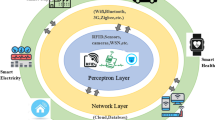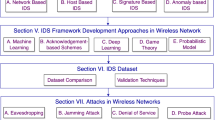Abstract
Mobile ad-hoc networks are a type of self-configuring networks in which the node moves from one location to another without any fixed infrastructure. Providing security in mobile ad-hoc networks is a challenging task due to its frequent topology change. Protecting legitimate nodes from the malevolent nodes is an important factor. To solve this problem, we propose trusted agent-based lightweight surprise check for malevolent node detection in mobile ad-hoc networks. This scheme uses three phases: lightweight surprise check manager, cluster formation and mobile agent phase. Lightweight surprise check manager detects the malevolent node based on node forward rate, node acknowledgement, secure communication and node location. In cluster phase, the clusters are formed depending upon received signal strength and the cluster heads are elected based on the residual energy and utility of neighbors. In mobile agent phase, the secret key method is used to verify the mobile agent authentication. The mobile agent is used for data communication among cluster head to destination, thus it reduces the energy utilization, network overload, average delay as well as improve the network efficiency in the network. Simulation results shows that the lightweight surprise check scheme provides improved security and quality of service compared to the existing schemes.















Similar content being viewed by others
References
Abdalla AM, Saroit IA, Kotb A, Afsari AH (2011) Misbehavior nodes detection and isolation for MANETs OLSR protocol. In: World conference on information technology, procedia computer science, vol 3, pp 115–121
Amin R, Biswas GP (2015) Cryptanalysis and design of a three-party authenticated key exchange protocol using smart card. Arab J Sci Eng 40(11):3135–3149
Ayday E, Lee H, Fekri F (2010) Trust management and adversary detection for delay tolerant networks. In: Military communications conference, IEEE, 2010-MILCOM 2010, pp 1788–1793
Deepika K, Dhurandher SK, Reddy BVR (2018) Power aware malicious nodes detection for securing MANETs against packet forwarding misbehavior attacks. J Ambient Intell Humaniz Comput 9(4):941–956
Duan Z, Zhai G, Xiang Z (2016) Exponential consensus for hierarchical multi-agent systems with switching topology and inter-layer communication delay. IET Control Theory Appl 10(4):451–460
Fan Y, Ye Y, Chen L (2016) Malicious sequential pattern mining for automatic malware detection. Expert Syst Appl 52:16–25
Farhan AF, Zulkhairi D, Hatim MT (2008) Mobile agent intrusion detection system for mobile ad-hoc networks, a non-overlapping zone approach. In: 4th IEEE/IFIP international conference on Tashkent, pp 1–5
Gupta BB, Joshi RC, Misra M (2012) Distributed denial of service prevention techniques, vol 2, pp 268–276
Jangirala S, Mishra D, Mukhopadhyay S, Kumari S (2018) Provably secure biometric based authentication and key agreement protocol for wireless sensor networks. J Ambient Intell Humaniz Comput 9(4):875–895
Kachirski O, Guha R (2002) Intrusion detection using mobile agents in wireless ad hoc networks. In: Knowledge media networking, proceedings of IEEE workshop, pp 153–158
Khan U, Agrawal S, Silakari S (2015) Detection of malicious nodes (DMN) in vehicular ad hoc networks. Proc Comput Sci 46:965–972
Khatri P, Tapaswi S, Verma UP (2013) Clustering based on trust of a node in mobile ad–hoc networks. In: International symposium on security in computing and communication. Springer, Berlin, pp 150–161
Kumar R, Lokesh S, Devi MR (2018) Identifying Camouflaging Adversary in MANET Using Cognitive Agents. Wireless Pers Commun 102(4):3427–3441
Lingeshwari S, Natchadalingam R (2014) Provisioning of efficient authentication technique for implementing in large scale networks. Int J MC Sq Sci Res 6(1):23–31
Osama A, AlZubi A, Tolba A (2018) Trusted neighbor selection using activation function for secure routing in wireless sensor networks. J Ambient Intell Humanized Comput 28(1):1–11
Patil VN, Thorat SA (2013) Cross layer approach to detect malicious node in MANET. In: Computing, communications and networking technologies—IEEE (ICCCNT), 2013 fourth international conference, pp 1–6
Raj PN, Swadas PB (2009) DPRAODV: a dynamic learning system against blackhole attack in AODV based MANET. IJCSI Int J Comput Sci 2:54–59
Safarinejadian B, Hasanpour K (2016) Distributed data clustering using mobile agents and EM algorithm. IEEE Syst J 10(1):281–289
Shakshuki EM, Kang N, Sheltami TR (2013) EAACK—a secure intrusion-detection system for MANETs. IEEE Trans Ind Electron 60(3):1089–1098
Shiokawa S (2010) A migration algorithm for mobile agent based on predicted lifetime in MANET. In: Proceedings of the 2nd IFIP conference on wireless days. IEEE Press, Paris, pp 7–12
Talreja R, Jethani V (2014) A vote based system to detect misbehaving nodes in MANETs. In: Advance computing conference (IACC), 2014 IEEE international, pp 391–394
Vijayakumar A, Selvamani K (2015) Reputed packet delivery using efficient audit misbehaviour detection and monitoring method in mobile ad hoc networks. Proc Comput Sci 48:489–496
Xu L, Wu F (2015) Cryptanalysis and improvement of a user authentication scheme preserving uniqueness and anonymity for connected health care. J Med Syst 39(2):1–9
Zhang Y, Lazos L, Kozma W (2016) AMD: audit-based misbehavior detection in wireless ad hoc networks. IEEE Trans Mob Comput 15(8):1893–1907
Author information
Authors and Affiliations
Corresponding author
Additional information
Publisher’s Note
Springer Nature remains neutral with regard to jurisdictional claims in published maps and institutional affiliations.
Rights and permissions
About this article
Cite this article
Aranganathan, A., Suriyakala, C.D. An efficient secure detection and prevention of malevolent nodes with lightweight surprise check scheme using trusted mobile agents in mobile ad-hoc networks. J Ambient Intell Human Comput 10, 3493–3503 (2019). https://doi.org/10.1007/s12652-018-1069-8
Received:
Accepted:
Published:
Issue Date:
DOI: https://doi.org/10.1007/s12652-018-1069-8




